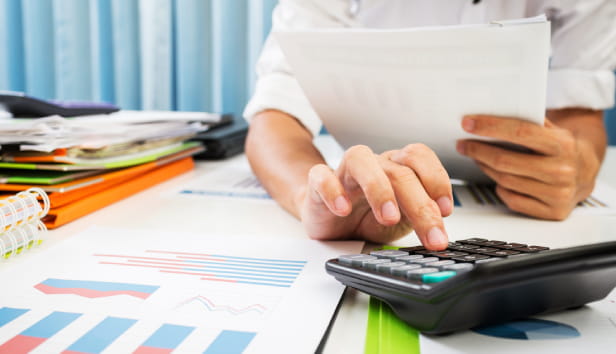
This article is for general guidance only and is not financial or professional advice. Any links are for your own information, and do not constitute any form of recommendation by Saga. You should not solely rely on this information to make any decisions, and consider seeking independent professional advice. All figures and information in this article are correct at the time of publishing, but laws, entitlements, tax treatments and allowances may change in the future.
Retirement can come with a whole host of decisions about how to make the best use of your money – decisions that can affect your financial wellbeing for years to come. There are questions of how and when to take your pension, and even whether you could be owed money from your pension. And there’s tax planning to think about too. We’ve asked independent experts for their views, to help you navigate the key issues.
If you’re saving for retirement with a defined contribution pension (often called a personal or money purchase pension), you’ll need to decide what to do with your pot of money when you retire. Defined contribution pensions are different to defined benefit pensions, such as final salary or career average pensions, where you’ll get a guaranteed income based on your earnings. There are several ways of generating income from defined contribution pensions.
One popular option is drawdown, which means your pension pot remains invested, so it will hopefully continue to grow (bearing in mind that the value of investments can fall as well as rise). You choose to take as much or as little income from it as you like.
Any money left over from drawdown can be passed on to your loved ones. Up until the October 2024 Budget this has been exempt from inheritance tax, but the Budget set out that from April 2027, pensions will become subject to inheritance tax. The pension payments to your beneficiaries remain also be free of income tax if you die before the age of 75, but are taxable if you die after 75.
Not all pensions offer income drawdown, so in some cases you might need to transfer your pot into a personal pension to get fully flexible access. (If you’re considering a transfer, make sure you check for any exit charges – it may be useful to take professional advice from a financial adviser.)
The most important thing with drawdown is to understand that your income is not guaranteed. If you take too much money out, or the stock market falls, you could be forced to reduce your income and you could even run out of money.
Recent FCA data shows well over 200,000 drawdown pots (43% of the total of those taking regular income) had withdrawal rates of 8% or more a year – a high rate, which won’t be sustainable for many retirees.
Helen Morrissey, Head of Retirement Analysis at wealth firm Hargreaves Lansdown, says: “If this is continued over a number of years, there’s a good chance you’d need to make tough income choices later.”
She adds: “[One] way of using drawdown is to adopt a ‘natural yield’ approach. This is where you only take the income generated by your investment return.”
This does mean your income will go up and down. Morrissey suggests keeping one to three years' worth of essential expenses in a bank account to help you smooth these dips, with money to draw from in leaner times.
Another way to stretch your pension as far as possible is “being prudent in your assumptions of what the stock market returns may be, as this allows you to work out a safe drawdown rate,” according to Ian Cook, Financial Planner at wealth management firm Quilter Cheviot.
He also suggests exercising caution with your investment choices as you get older, to avoid stock market losses eating into your retirement funds.
Another option is buying an annuity, which means handing over some or all of your retirement savings to an insurance company and getting a guaranteed income (usually for life) in return.
But while this option has been rising in popularity since the pandemic, thanks to the improving rates on offer, it isn’t as flexible as taking drawdown from your pension. Buying an annuity is also an irreversible decision.
You don’t have to use all your pot to buy an annuity. You could use some of it to buy guaranteed income and then leave the rest invested in drawdown.
Alternatively, you could start out in drawdown and buy an annuity further down the line. Some people choose this approach if they’re taking a “phased retirement” (where they start off by reducing their working hours before stopping work altogether at a later date).
Buying an annuity later should also mean receiving a higher rate, as you’ll be older and potentially have more health problems, and will have fewer years left to take your annuity.
You don’t have to buy your annuity from your pension provider, and you can usually get a better deal by shopping around. There are many different types of annuities available, including enhanced annuities for people who smoke or have health problems, which may pay a higher rate. Age UK has more information about the different options.
As well as drawdown and annuities, there are options to take your pension either in one go, or as a number of lump sums. There are various different ways to do this.
Depending on the size of your pension, you might withdraw the 25% of your pension that you are allowed to take as a tax-free lump sum, and use this money to live on until you need to withdraw more.
If you take a number of lump sums, you can decide how much pension money to take and when to take it. Your pot stays invested and you take small lump sums over time until it runs out. Usually 25% of each amount you take out is tax-free.
You can also take your whole pension pot as cash in one go – in which case 25% will be tax-free and the other 75% will be taxed at your marginal rate of tax along with any other income you have. This approach can have drawbacks, including the fact that you won’t have a long-term income, and you could end up with a large tax bill. So it’s not a decision to take lightly. The government’s Money Helper website has more information on this.
You can also go for a mix of options (especially if you have more than one pension).
If you’re still paying into your pension when you start to take your pension, bear in mind that the way you take your pension could potentially affect the amount of tax relief you get on your contributions. The Money Helper website has more about this.
Turning your pension into income can be a tricky decision and it’s your responsibility to make sure your money doesn’t run out. This means it’s a good idea to consult a qualified and regulated financial adviser. If you’re uncertain about choosing investments and managing your pension throughout your retirement using drawdown, they’ll also be able to help with those decisions too.
It’s worth remembering that from age 50 you’re entitled to free guidance from Pension Wise. Unlike a financial adviser, this service cannot provide bespoke advice or make recommendations for you, but can guide you through the pension options.
If you don’t need it yet, deferring one or more of your pensions might be an option for you.
Deferring your State Pension will boost how much you get each week when you do take it. And if you delay taking your pension for just a year, you can benefit from as much as £667 more a year in State Pension for life. However, it’s not the right decision for everyone.
If you’re approaching State Pension age (currently 66, rising to 67 by 2028) and think you can manage without the State Pension for a while – perhaps if you’re still working, have enough private pension income or are able to live off other sources like ISAs – deferring the State Pension may be a good idea.
Around two months before you reach State Pension age, you’ll receive a letter from the government saying you’ll soon be eligible to claim (as you don’t receive the State Pension automatically).
To defer your State Pension, you simply don’t claim. The longer you leave it, the bigger the increase you could get. However, Morrissey says you need to weigh up the extra money received by deferring versus the money given up today. “A full new State Pension is currently worth around £11,500 per year – you need to think about how long it will take to make that back to make sure you really get your money’s worth,” she says. It takes around 17 years to recoup the income given up for just one year, so it's worth thinking about your health and how long you’re likely to live before you decide to defer.
You should also consider your tax situation – if you’re still working then you may get taxed on your State Pension as well as your existing income.
If your National Insurance (NI) record means you don’t fully qualify for the State Pension, deferring while you’re still working may help you to build up your pension entitlement (you need 35 years of NI contributions to get the full new State Pension and a minimum of 10 years to get any State Pension.)
You can still defer your State Pension if you’ve already started taking it – but only once. You can’t build up any extra pension if you or your partner are receiving certain benefits, such as Pension Credit.
If you have a defined contribution scheme, deferring it will mean that the money doesn’t need to last as long when you do start taking it. If you leave your money invested, it may grow further (although investments can also fall in value).
You and/or your employer may be able to continue to pay into it, though you should check if your scheme has any restrictions on this.
Some defined benefit pension schemes may not allow you to defer claiming your pension. Others might allow you to build up extra entitlement if you work beyond normal retirement age, but this depends on scheme rules (and there is usually a cut-off age at which you need to start taking your pension). Check with your employer or pension administrator to find out what rules apply to your scheme.

More retirees than ever are now paying tax on their income, thanks mainly to income tax allowances having been frozen at their current level since 2021. The thresholds are not due to rise until 2028.
If you’re likely to receive a combination of private and State Pension income when you retire, or you plan to carry on working in some way, you’ll very likely have to pay some income tax. This kicks in once your overall income exceeds the personal allowance, which is currently £12,570 a year.
When thinking about tax, Cook suggests looking at all your income sources, especially ISAs as they can provide tax-free income. In some cases, it might be worth taking some income out of any ISAs you might have, if drawing from your pension is going to cost you 20% tax.
If you aren’t sure how which is the most tax-effective way to plan your retirement income, a qualified adviser can help and show you how any decisions could affect your finances further down the line.
If you don’t want to dip into savings, some pension providers will allow you to draw differing levels of income and tax-free cash, such as taking out your personal allowance as taxable income and topping up the remainder of your income from your tax-free cash allowance (25% of your total pot is tax-free).
“Eventually you will still pay tax at your marginal rate on income, but your pension fund will have had a chance to continue to grow in a tax-free environment,” says Cook.
Hundreds of thousands of people have been underpaid their State Pension due to administrative errors, meaning they’re due a back payment. Women are more likely to be affected. These underpayments range from a few hundred pounds to £100,000.
Those affected fall into three categories:
Since March 2021 the DWP has been checking hundreds of thousands of pension records and informing those it thinks are owed money. This means that some married women, widows and those aged over 80 should be getting payments without having to take any action.
Tom Selby, Public Policy Director for AJ Bell, says: “If you have been underpaid your State Pension, the DWP should inform you. If you think you have been underpaid and haven’t been contacted, you can contact DWP to make your case.” The problem is, the State Pension can be a complex and difficult benefit to navigate. It has undergone numerous changes over the years which have created different systems and inevitably, some people or payments have fallen through the gaps.
In most cases HMRC or the DWP should be able to automatically correct any underpayments, but on occasion this may not be possible. The best way to check how much you are owed is to look at your National Insurance record, says Cook: “This is the determining factor of how much of the State Pension you will receive, so check this and it should allow you to work out if you have any underpayments.”
Additionally, if you think your National Insurance record has been understated, and you have the evidence to back this up, then you should speak to the government’s Pension Service to get it corrected. Pension consultancy LCP has also developed two online tools – one for married women and another for widows and widowers – to see if they are owed anything.




.jpg?la=en&h=354&w=616&hash=1254A3F816E81965A47EA68E3AEC9F7A)



Learn how much pension you need & get tips to boost your savings if you're short.

Boost your bank balance by claiming back everything you’re entitled to